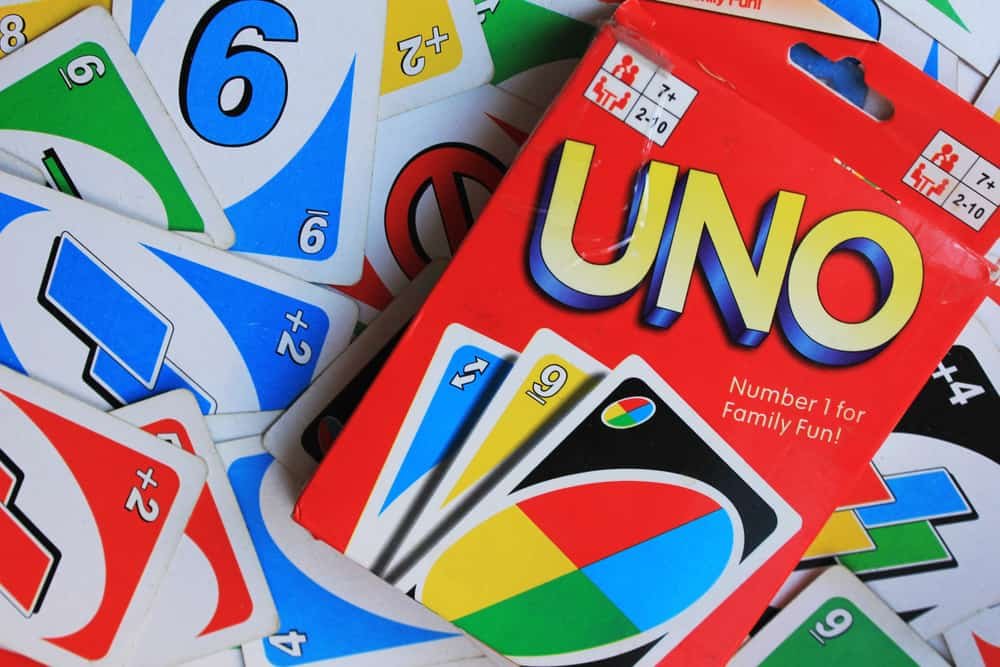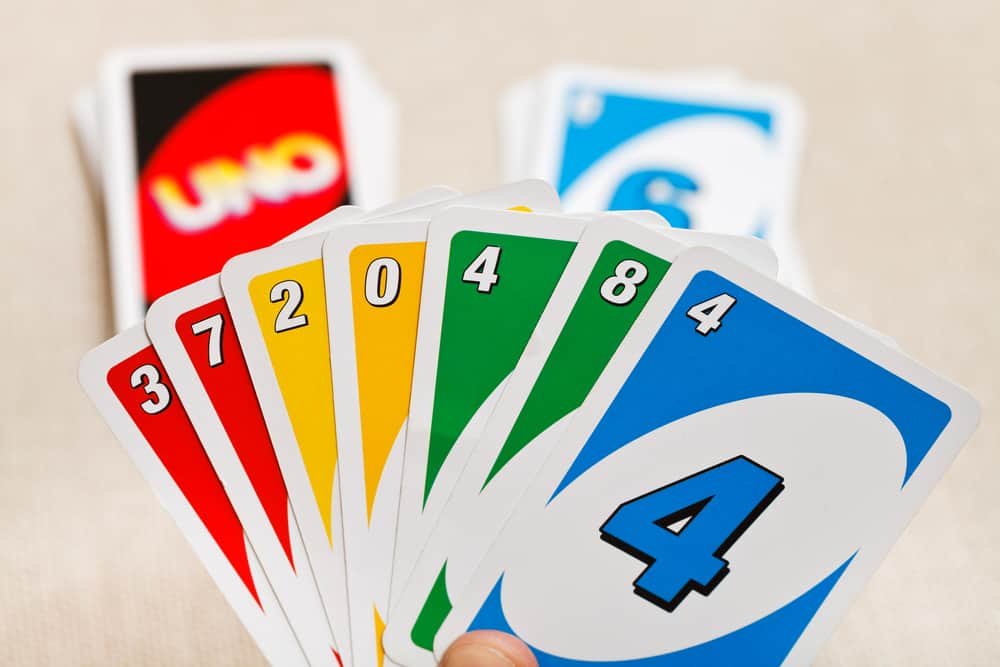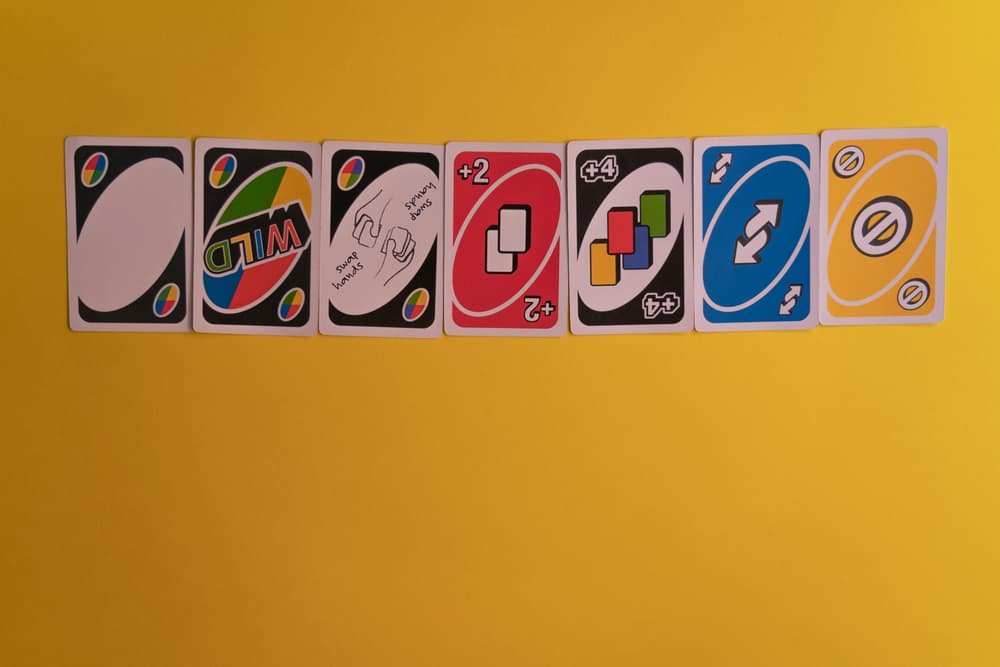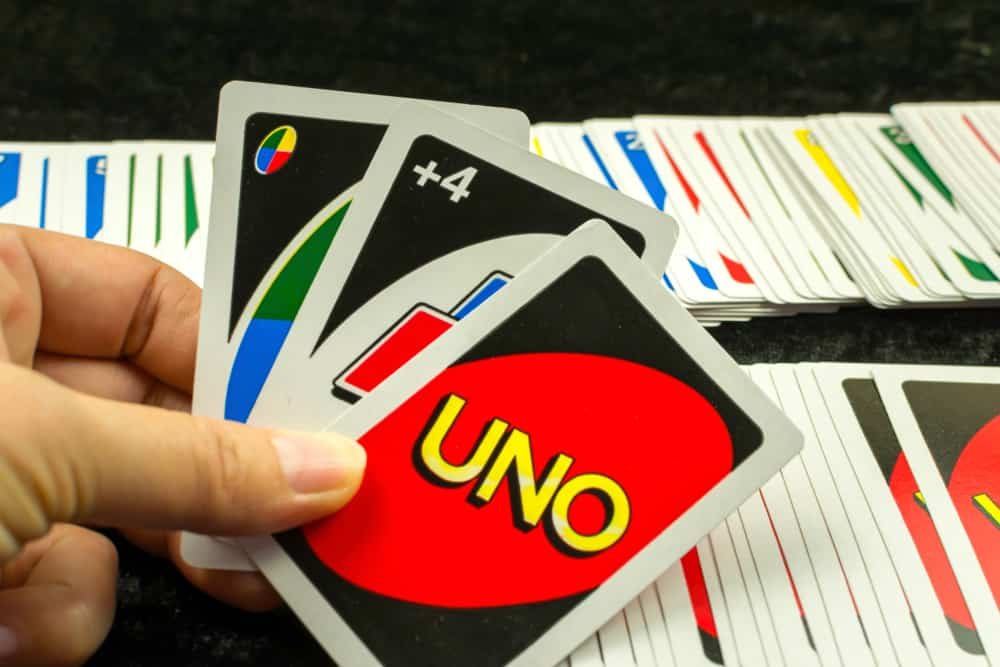Draw 100 Card Uno Rules

UNO is a game for the whole family; it is a recommended game for young and old to play together. That is what makes it such a firm favorite for family gatherings. While the game is designed for 7 years and up, you can teach younger children to play the game with a fair amount of ease.
What makes UNO so popular is that it is fun, quick to play, and provides hours of entertainment. The rules of the game are quick and easy to learn – you are about to find that out right now.
How to play UNO – General rule of play (according to Mattel ):
| 1. | To start the game, shuffle the deck and deal 7 cards (facedown) to each player. Stack the remaining cards (facedown) into a draw pile. |
| 2. | Turn over the top card on the draw pile to form a discard pile. |
| 3. | The player to the left of the dealer starts the game. |
| 4. | That player must then match the card on the discard pile. Either by playing another card of the same color, another card of a different color but with the same number, or Wild card or Wild Draw 4 card. |
| 5. | If the player does not have a card that can be played, he/she must draw a card from the draw pile. The card can be played immediately; otherwise, it must be added to the hand. |
| 6. | After a card is played or drawn, the next player continues to play. |
| 7. | Continue counterclockwise. |
| 8. | When you are down to your last card, you have to announce "UNO" immediately. |
| 9. | Continue to play until one of the players is out of cards. |
UNO is played with a deck of 108 cards that are spread over 4 color suits: blue, red, green, and yellow (there are 19 cards in each color suit). The deck of cards also has several special cards (8 of each), including "Draw 2" cards, "Skip" cards, "Reverse" cards, "Wild Draw 4" cards, and "Wild" cards.
The first time you encounter the game, you might feel overwhelmed by all the cards, but once you familiarize yourself with them, they will begin to appear self-explanatory – because they are.
How to Play UNO | The Official Rules

To understand the rules, it is probably a good idea to get out your deck of UNO cards and check out each card-related rule with the card in front of you. Ready to take a look at the official rules related to the list of areas mentioned above? Let's jump right in!
The object of the UNO Game
The first thing you need to do is make sure that you understand the objective of the game. The rules of the game support the objective, while making it challenging at the same time. The objective of the game is for the player to play (get rid of) all of the cards in his/her hand before the other players. The first player to play all of his/her cards scores points for each of the cards that the other players still have. The winner of the game is the first player to reach 500 points.
How to set up UNO
To start the game, a dealer needs to be selected. According to the official UNO game rules, each player needs to draw a card from the pile to determine who the dealer is. The player with the highest card number is the dealer.
The deck of cards must then be shuffled and each player given 7 cards. The leftover cards are then turned face down and placed in a pile in the center of the table or playing surface. The top (first) card is turned over and placed next to the draw pile to form the playing pile or "discard pile". If the first card turned over happens to be a special card (which is any card other than a number card), the cardcan be replaced into the pile randomly, and another card turned over (otherwise follow the rules below).
Now everyone can review their hand of cards, and the game can begin. Regular number cards can be number and color-matched. This means that if you have a card of the same color, you can play it, and if you have a card that is of another color but of the same number, you can play it.
Using Special Cards
There are several special cards included in a deck of UNO cards. These cards add a fun twist to the gameplay. The rules of play for each card must be strictly adhered to. And here they are:

– Reverse Card
The reverse card is quite handy because it can change the direction of play. If it is the first card turned over on the pile, the game plays in an anti-clockwise direction. The Reverse Card can only be played on top of another Reverse Card or on a card of the same color.
– Wild Card
When a player uses a Wild Card, it is to change the color of the game. The player using this card can either select a new color or select the same color already being played. You can play this card even if there are other cards that can be played. The Wild Card can be played on top of any other card, and if it is the first card turned over at the start of play, the first player can choose the color of the game and also play the first card.
– Skip Card
When a Skip Card is played, the player who is set to play next misses his/her turn. If the first card turned over is a Skip Card, the first player actually misses his/her turn. This particular card can only be played on top of another Skip Card or on a card of the same color.
– Draw 2 Card
If this card is the first to be turned over at the beginning of the game, the first player must pick up 2 cards and then allow the next player to play. When a Draw 2 Card is played, the next player has to pick up 2 cards from the draw pile and forfeit their actual turn (this means that the player cannot play any cards from their hand).
– Wild Draw 4 Card
This card is a double whammy for the next player, as when it is played, the color of the game/round is changed, and the next player misses his/her turn and picks up 4 cards from the draw pile. This card cannot be played at any time, though. The Wild Draw 4 Card can only be played if the player has no card in his/her hand that matches the color of the previous card played.
The Rule of Calling "UNO"

If you have watched a game of UNO before, you might have noticed that players shriek "UNO" at some point in the game. This is the rule of calling UNO in action. When a player is about to play to his/her second to last card, they have to announce it by saying "UNO". If a player does not call UNO, and another player notices before the next person plays, the offending player must pick up 4 cards from the draw pile. Once the next player has drawn or played a card, the player in question is safe and cannot be "caught out" by other players.
Reneging in UNO
If you have a playable card but do not really want to play it for strategic reasons, you can renege. This means that you can withhold the playable card and draw a card from the draw pile instead. If the card that you have drawn is a playable card, you can play it immediately. If the card is not playable, you cannot then select another card from your hand to play. Instead, the card is kept, and the next player takes his/her turn.
Scoring Rules of UNO
It is important to keep the score at the end of each round. When a player plays their last card, the round is considered over. Using a note pad and pencil, make a note of what cards each player is left with and who won each round, at the end of each round. The cards have the following values attached to them:
- Number cards: these cards carry the same value as the number printed on the card.
- Draw 2 cards: these cards have a 20-point value.
- Skip cards: these cards have a 20-point value.
- Reverse cards: these cards have a 20-point value.
- Wild cards: these cards have a 50-point value.
- Wild Draw 4 cards: these cards have a 50-point value.
When a player reaches 500 points, he/she is the winner of the game.
Last Word
Understanding UNO is actually quite easy. Once you start playing, it gets easier and easier. In fact, the rules are so quick and easy to learn that it should only take a round or 2 for you to get a hold of the rules and start having fun. Enjoy, and good luck!
If you're more of a visual learner, I'll suggest you check the following YouTube clip from the YouTube channel "Triple S Games". They do a great job at explaining the game.
Source: https://www.gamesver.com/uno-game-the-rules-how-to-play-according-to-mattel/
0 Response to "Draw 100 Card Uno Rules"
Post a Comment